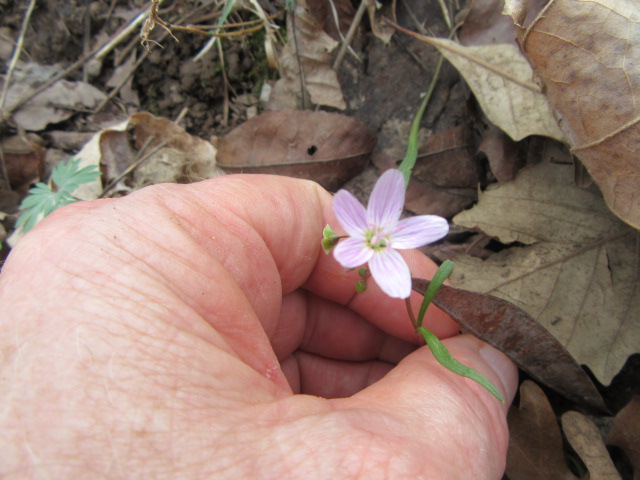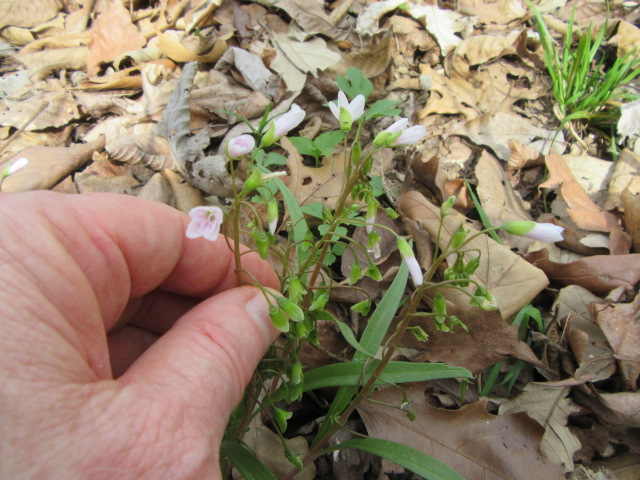
Claytonia virginica (Virginia Spring Beauty) on 4-11-20, #686-15.
Virginia Spring Beauty, Eastern Spring Beauty
Claytonia virginica
play-TOH-nee-uh vir-JIN-ih-kuh
Synonyms of Claytonia virginica (19) (Updated on 12-21-23): Claytonia acutiflora (DC.) Sweet, Claytonia bodinii Holz., Claytonia cautiflora Sweet, Claytonia grandiflora Sweet, Claytonia linearis Raf., Claytonia media (DC.) Link, Claytonia multicaulis var. robusta Somes, Claytonia ozarkensis John M.Mill. & K.L.Chambers, Claytonia robusta (Somes) Rydb., Claytonia simsii Sweet, Claytonia virginica var. acutiflora DC., Claytonia virginica var. graminifolia Gatt., Claytonia virginica var. hammondiae (Kalmb.) Doyle, Lewis & D.B.Snyder, Claytonia virginica f. hammondiae Kalmb., Claytonia virginica f. lutea R.J.Davis, Claytonia virginica var. media DC., Claytonia virginica f. micropetala Fernald, Claytonia virginica f. robusta (Somes) E.J.Palmer & Steyerm., Claytonia virginica var. simsii (Sweet) R.J.Davis
Claytonia virginica L. is the accepted scientific name for the Virginia Spring Beauty. The genus and species were named and described as such by Carl von Linnaeus in the first volume of the first edition of Species Plantarum in 1753.
As of 12-21-23 when this page was last updated, Plants of the World Online lists 33 species in the Claytonia genus. It is a member of the plant family Montiaceae with 16 genera. Those numbers could change as updates are made on POWO.

Distribution map of Claytonia virginica from Plants of the World Online. Facilitated by the Royal Botanic Gardens, Kew. Published on the Internet; http://www.plantsoftheworldonline.org/. Retrieved on May 5, 2021.
The above distribution map for Claytonia virginica is from Plants of the World Online. The map on the USDA Plants Database for the United States and Canada is similar and also includes South Carolina and New Brunswick. The species could have a wider range than the maps show.
The map on iNaturalist shows where members have made observations. Anyone can join and it is a great website to confirm and share your observations. The maps on iNaturalist are continually updated as members post new observations.
THERE ARE SEVERAL LINKS AT THE BOTTOM OF THE PAGE FOR FURTHER READING AND TO HELP WITH A BETTER POSITIVE ID.

Claytonia virginica (Virginia Spring Beauty) on 4-11-20, #686-16.
I spotted a neat wildflower growing in the back southeast pasture on April 11 in 2020. It was all by itself with several buds and one flower beginning to open. It was growing a few feet from the fence.
Photos taken in 2022 are at the bottom of the page below the links for further reading.

Claytonia virginica (Virginia Spring Beauty) on 4-11-20, #686-17.
I took several photos because I thought it was pretty neat. It had a pair of strange, thick grass-like leaves on the stem and I didn’t notice any basal leaves.

Claytonia virginica (Virginia Spring Beauty) on 4-11-20, #686-18.
I noticed a few pink stamens inside the flower which was also strange for them to be that color.

Claytonia virginica (Virginia Spring Beauty) on 4-11-20, #686-19.
The buds were just hanging in a pendulous manner. How interesting…

Claytonia virginica (Virginia Spring Beauty) on 4-11-20, #686-20.
I walked about 12 feet into the clearing and spotted quite a few plants with open flowers. That resulted in MANY more photos. I returned to the house with 138 photos of several wildflower species, not counting about 30 I had taken of the perennials that morning. Not wanting to waste time going through multiple photos online to figure out what this plant was, I used the drag-and-drop feature on iNaturalist. Within seconds the plant was identified as Claytonia virginica commonly known as Virginia Spring Beauty. After doing some further research I found other common names such as Eastern Spring Beauty, Spring Beauty, and Good Morning Spring. There are probably other names besides.

Claytonia virginica (Virginia Spring Beauty) on 4-11-20, #686-21.
Flowering stems grow to 4-6” tall but after flowering, the grass-like leaves continue to grow to reach 9-12” tall before disappearing as the plants go into dormancy. The stems are smooth (glabrous) and green or purplish-tinged.

Claytonia virginica (Virginia Spring Beauty) on 4-11-20, #686-22.
Not all plants seemed to have basal leaves or very few, but they are thick, fleshy, and dark green, linear to oblanceolate tapering to a sharp point. Leaves can have short to long petioles that are sometimes red-tinged. The stems have only one pair of leaves (#686-16, second photo), are thick and linear, grow opposite one another, and are sessile (no petioles) or may have short petioles.

Claytonia virginica (Virginia Spring Beauty) on 4-11-20, #686-23.
The inflorescence grows on the top of the flowering stems and includes 5-18 flowers all seemingly growing to one side.

Claytonia virginica (Virginia Spring Beauty) on 4-11-20, #686-24.
The above photo is of a nice colony with multiple open flowers.

Claytonia virginica (Virginia Spring Beauty) on 4-11-20, #686-25.
The flowers have five white or pinkish petals with darker pink veins and five stamens.

Claytonia virginica (Virginia Spring Beauty) on 4-11-20, #686-26.
Claytonia virginica needs damp springs to survive and dry springs will result in them dying. If they are found growing in your yard, continual mowing for several years will also end in their demise. It would be better if you dug up and moved them to a more protected area. If transplanting, plant the corms 3″ deep and 3″ apart. I noticed several websites offering them for sale.

Claytonia virginica (Virginia Spring Beauty) on 4-23-20, #690-27.
I went back into the woods on April 23 to see what other wildflowers I could find. I always find a few new species and can’t seem to find a few previously discovered… I need to draw a map. The flowers on a few Claytonia virginica were a darker shade.

Claytonia virginica (Virginia Spring Beauty) on 4-23-20, #690-28.
A wider-leaved species, Claytonia arkansana, grows south of Missouri and is native to Arkansas. Formerly, a wider-leaved variety of C. virginica was named C. ozarkana but it is now considered a synonym.

Claytonia virginica (Virginia Spring Beauty) on 4-23-20, #690-29.
According to Wikipedia, the Iroquois gave Claytonia virginica as a cold infusion or a decoction made of powdered roots to children to treat convulsions. They also ate the roots because they believed they permanently prevented conception. The Iroquois and Algonquin people cooked their roots like potatoes. The leaves and stem are also edible…

Claytonia virginica (Virginia Spring Beauty) on 4-23-20, #690-30.
I have enjoyed photographing and learning about the many wildflowers growing on the family farm and in other areas. The farm is in Windsor, Missouri in Pettis County (Henry County is across the street, and Benton and Johnson aren’t far away). I have grown over 500 different plants and identified over 250 species of wildflowers (most have pages listed on the right side of the blog). I am not an expert, botanist, or horticulturalist. I just like growing, photographing, and writing about my experience. I rely on several websites for ID and a horticulturalist I contact if I cannot figure them out. Wildflowers can be somewhat variable from location to location, so sometimes it gets a bit confusing. If you see I have made an error, please let me know so I can correct what I have written.
I hope you found this page useful and be sure to check the links below for more information. They were written by experts and provide much more information. Some sites may not be up-to-date but they are always a work in progress. If you can, I would appreciate it if you would click on the “Like” below and leave a comment. It helps us bloggers stay motivated. You can also send an email to me at thebelmontrooster@yahoo.com. I would enjoy hearing from you especially if you notice something is a bit whacky
FOR FURTHER READING:
PLANTS OF THE WORLD ONLINE (GENUS/SPECIES)
INTERNATIONAL PLANT NAMES INDEX (GENUS/SPECIES)
TROPICOS (GENUS/SPECIES)
FLORA OF MISSOURI (GENUS/SPECIES)
FLORA OF NORTH AMERICA (GENUS/SPECIES)
WORLD FLORA ONLINE (GENUS/SPECIES)
WIKIPEDIA (GENUS/SPECIES)
USDA PLANTS DATABASE
MISSOURI BOTANICAL GARDEN
MISSOURI PLANTS
iNATURALIST
WILDFLOWER SEARCH
DAVE’S GARDEN
ILLINOIS WILDFLOWERS
MINNESOTA WILDFLOWERS
KANSAS WILDFLOWERS AND GRASSES
PFAF (PLANTS FOR A FUTURE)
GO BOTANY
LADY BIRD JOHNSON WILDFLOWER CENTER
FLORA FINDER
BACKYARD NATURE
LAKE FOREST COLLEGE ENVIRONMENTAL STUDIES
FRIENDS OF THE WILDFLOWER GARDEN
EAT THE WEEDS
NOTE: The data (figures, maps, accepted names, etc.) may not match on these websites. It depends on when and how they make updates and when their sources make updates. Some websites have hundreds and thousands of species to keep up with. Accepted scientific names change periodically and can be hard to keep with. Some of the links may use a name that is a synonym on other sites. In my opinion, Plants of the World Online by Kew is one of the most reliable and up-to-date plant databases and they make updates regularly. I make updates “at least” once a year and when I write new pages or add new photos but I do get behind. We are all a work in progress. 🙂
MORE PHOTOS…

Claytonia virginica (Virginia Spring Beauty) on 4-11-22, #867-3.

Claytonia virginica (Virginia Spring Beauty) on 4-20-22, #870-15.

Claytonia virginica (Virginia Spring Beauty) on 4-20-22, #870-16.

Claytonia virginica (Virginia Spring Beauty) on 5-1-22, #877-2.

Claytonia virginica (Virginia Spring Beauty) on 5-1-22, #877-3.

Claytonia virginica (Virginia Spring Beauty) on 5-1-22, #877-4.

Claytonia virginica (Virginia Spring Beauty) on 3-31-24, #981-3.

Claytonia virginica (Virginia Spring Beauty) on 3-31-24, #981-4.

Claytonia virginica (Virginia Spring Beauty) on 3-31-24, #981-5.

Claytonia virginica (Virginia Spring Beauty) on 3-31-24, #981-6.

Claytonia virginica (Virginia Spring Beauty) on 3-31-24, #981-7.